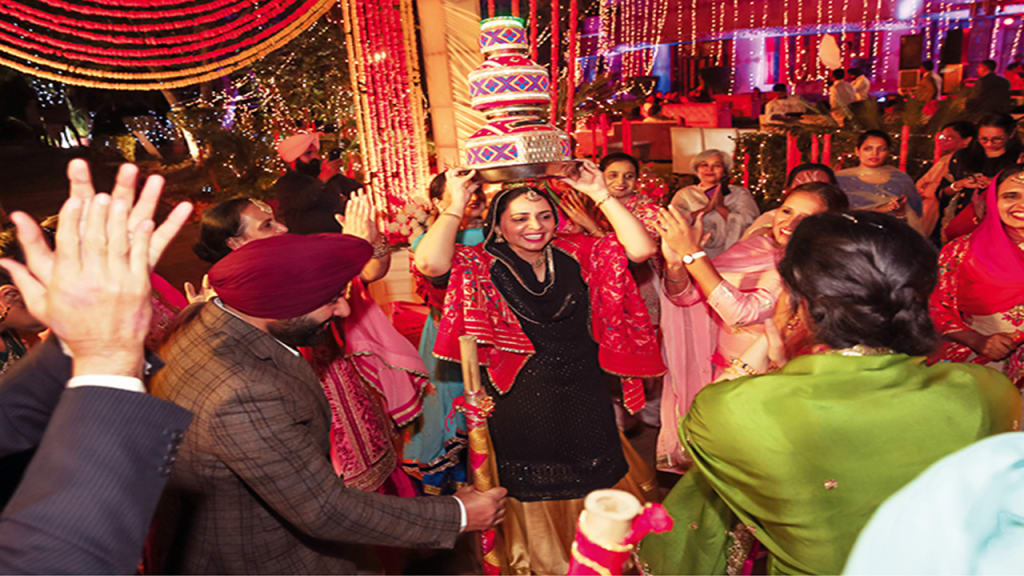Pushkara (Milni): The Warm Embrace of Elders and Loved Ones in Wedding Processions
Old Marriage Rituals of Punjab

Introduction:
Pushkara, also known as Milni, is an age-old tradition that holds immense cultural significance in weddings, particularly in Punjab and other regions of India. This ritual involves the gathering of elders and loved ones from the bride's side to formally welcome the wedding procession, known as the barat. In this article, we will explore the rich customs and symbolism associated with Pushkara (Milni). We will delve into the traditional practices followed during this ritual, the emotions it evokes, and its importance in strengthening familial bonds and community ties.
The Gathering of Elders and Loved Ones:
Pushkara (Milni) signifies the coming together of the elders and dear ones of the bride to warmly receive the barat, which includes the groom, his family, and accompanying guests. This ritual holds a special place in the hearts of families and communities, as it symbolizes unity, respect, and the merging of two families.
In traditional settings, particularly in villages, the barat would arrive on the wedding day and be hosted in the takiye (haveli). The takiye was a designated place where the barat would be accommodated and received by the bride's family. It served as a hub of anticipation and excitement, preparing for the formal welcome ceremony of the procession.
The Evening Welcome with Torches:
As the sun set and darkness enveloped the night, the elders and loved ones of the bride would gather, holding torches in their hands, to formally welcome the barat. This evening welcome ceremony added a touch of mystique and heightened the emotions surrounding the wedding festivities.
Both groups, the bride's side and the groom's side, would stand face to face at a certain distance from each other, creating a sense of anticipation and excitement. The torches held by the elders illuminated the surroundings, creating a magical atmosphere. The flickering flames symbolized warmth, light, and the guidance of elders in the couple's new journey.
The Ritual of Milni:
Milni, the heart of the Pushkara ritual, involved select elders and leading individuals from both parties stepping forward to embrace each other with great warmth and affection. This embrace, often accompanied by tears of joy, marked the official union and acceptance of the families.
The Milni served as a symbolic gesture of unity, respect, and the merging of families. It signified the coming together of two distinct lineages and the establishment of a new bond. Through this warm embrace, the elders expressed their love, blessings, and acceptance of the groom and his family into the bride's family.
The emotions evoked during the Milni were profound and heartfelt. It was a moment of overwhelming joy, as generations united and shared their blessings for the couple's future. The embrace also represented the collective love and support of the community, as the wider circle of loved ones witnessed this gesture of unity and celebrated the union of two families.
Strengthening Familial and Community Bonds:
Pushkara (Milni) not only holds significance within the immediate families involved but also strengthens bonds within the broader community. This ritual fosters a sense of togetherness, harmony, and shared joy among relatives, friends, and neighbors.
The coming together of elders and leading individuals from both parties creates an opportunity for them to interact, exchange greetings, and forge stronger connections. The embrace during the Milni signifies a shared commitment to support and uplift the newly formed family. It symbolizes the importance of mutual respect, understanding, and harmony in nurturing successful marriages.
Furthermore, Pushkara (Milni) showcases the power of community support. The presence of loved ones, neighbors, and well-wishers adds to the celebratory atmosphere, creating an environment of collective joy and happiness. It reaffirms the couple's place within a broader social fabric and ensures that they have a network of support as they embark on their marital journey.
Evolution and Contemporary Adaptations:
As times have changed, certain aspects of the Pushkara (Milni) ritual have evolved to accommodate modern realities. While the essence of the ritual remains intact, the practicalities and logistics have been adapted to suit contemporary settings.
Today, the evening welcome with torches may be substituted with well-lit venues, decorative lighting, or symbolic representations of torches. The focus is still on creating a warm and inviting atmosphere to receive the barat, but with adaptations that align with current trends and preferences.
Similarly, the Milni itself has evolved to include more inclusive and diverse gestures of embrace. It is not limited to elders and leading individuals but may extend to a wider circle of relatives and friends. The emphasis is on building strong connections and fostering a sense of unity among all members of the families involved.
Conclusion:
Pushkara (Milni) is a cherished ritual that signifies the coming together of elders and loved ones to welcome the wedding procession. This tradition showcases unity, respect, and the merging of families. The evening welcome with torches and the heartfelt embrace during the Milni evoke profound emotions and strengthen familial and community bonds. While the ritual has evolved over time, its essence remains rooted in cultural values and the celebration of love and togetherness. As weddings continue to evolve, Pushkara (Milni) stands as a timeless reminder of the importance of unity, respect, and the enduring power of familial and community support.
About the Creator
Dr. Amjad Ali Bhatti
Dr. Amjad Ali Bhatti is a multifaceted individual who has made significant contributions in the fields of research, translation, literature, and social activism.






Comments
There are no comments for this story
Be the first to respond and start the conversation.